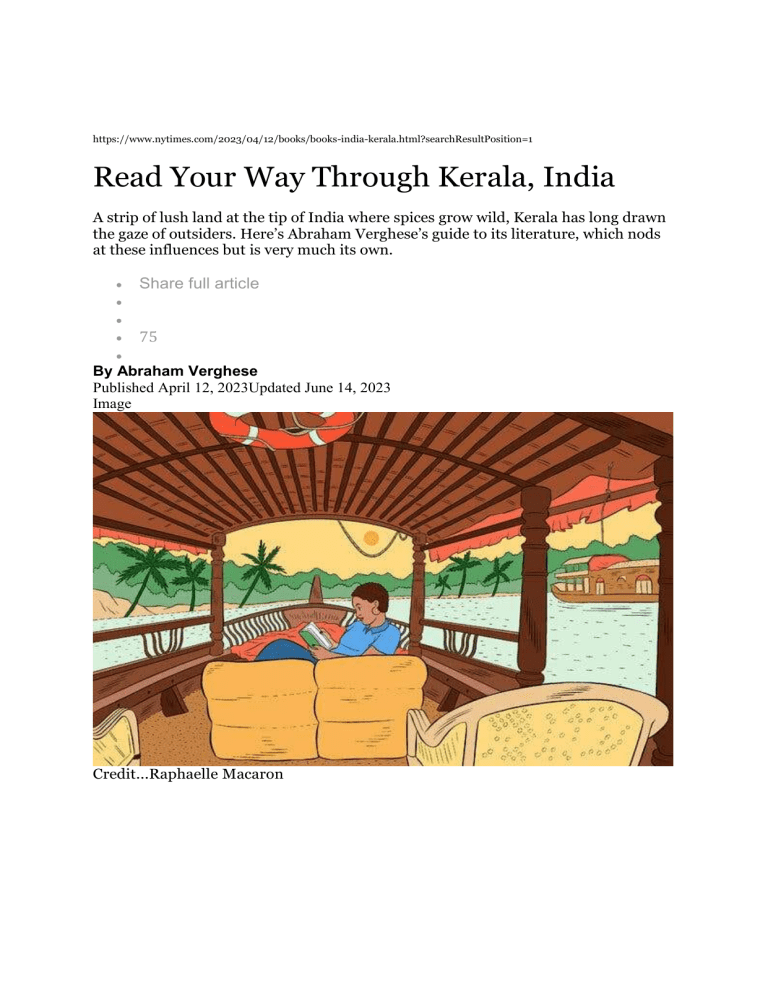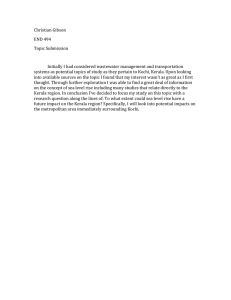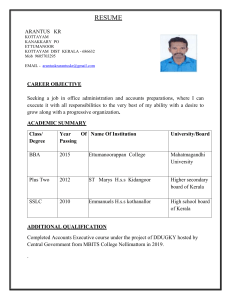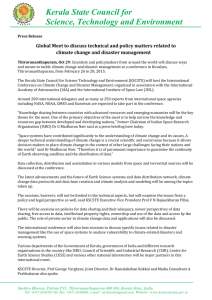
https://www.nytimes.com/2023/04/12/books/books-india-kerala.html?searchResultPosition=1 Read Your Way Through Kerala, India A strip of lush land at the tip of India where spices grow wild, Kerala has long drawn the gaze of outsiders. Here’s Abraham Verghese’s guide to its literature, which nods at these influences but is very much its own. Share full article 75 By Abraham Verghese Published April 12, 2023Updated June 14, 2023 Image Credit...Raphaelle Macaron Read Your Way Around the World is a series exploring the globe through books. If you arrive in Kerala from elsewhere in India, you’ll feel as though you’ve landed in a different country — “God’s own country,” as Keralites like to say. This strip of coastal territory at India’s southern tip, 350 miles long and 75 miles broad at its widest point, is shaped like a fish, with the head pointing to Sri Lanka, the tail to Goa, and the eyes gazing wistfully west across the Indian Ocean to Dubai, Abu Dhabi, Qatar, Oman, Kuwait and Saudi Arabia — the Gulf, or Persia in local parlance. Think of the Gulf as a Kerala annex, since three million Keralites — or Malayalis, speakers of Malayalam — work there; the money they send home makes up about a third of the state’s gross domestic product. Not surprisingly, the Gulf has shaped Kerala’s culture and literature. The territory sits between the Indian Ocean and the Western Ghats, the mountain range that runs parallel to the coast. Forty-four rivers run to the sea, spawning vast lakes, countless streams, lagoons, bottle-green lotus ponds and a latticework of backwaters that are Kerala’s giant circulatory system, with the annual monsoon its beating heart. Such liquid abundance shapes the lush green landscape dotted with palm trees, and also shapes Malayali character. I think it’s responsible for the fluid facial movements that allow Malayalis to convey volumes without uttering a word. ADVERTISEMENT SKIP ADVERTISEMENT Kerala’s uniqueness developed in part because the towering Western Ghats sheltered the state from invaders from the north, while the mountains’ fertile slopes allowed spices such as pepper and cardamom to grow wild. For centuries, Arab sailors caught the southwesterlies in the lateen sails of their dhows to come to the “Spice Coast.” When the winds reversed, they carried their purchases of pepper, clove, cardamom, ginger and cinnamon back to Venice or Genoa, where they sold them for small fortunes. Naturally, these sailors kept their source a secret from Europeans. Expeditions by Westerners in search of these precious spices all failed until Vasco da Gama, a Portuguese explorer, landed in present day Kerala in 1498. He was the first; the Portuguese were soon followed by the Dutch, the French and the English. What should I read before I go? Books on Kerala’s history can feel tedious. A first-time traveler is better off with a broader introduction to India, like V.S. Naipaul’s incisive and inimitable “India: A Million Mutinies Now,” paired with “The Idea of India,” by Sunil Khilnani. The latter argues that politics, more than culture or religious chauvinism, shaped modern India. Shashi Tharoor is a wonderful writer, as well as a politician and member of Parliament representing Kerala. His “Inglorious Empire: What the British Did to India” may make a Britisher squirm, but it is a necessary antidote to the romantic falsehood that the British civilized and modernized India, when in fact they built railways, roads and an administrative structure for the sole purpose of efficiently carrying their loot to Indian ports. Even the word “loot” is stolen from Hindi. Britain — not India — was modernized and industrialized by the spoils from the “jewel in the crown.” Inevitably, two centuries of British colonization have left a mark in complex ways, including the irony that many Indian writers — including Tharoor, and the author of this article — were educated in schools and universities modeled on the British system, and write and think in English. ADVERTISEMENT SKIP ADVERTISEMENT In anticipation of the unique and delectable cuisine that awaits you in your travels, read “The Kerala Kitchen,” by Lathika George: a colorful travelogue, memoir and cookbook. There’s a good chance your inbound flight will connect via Dubai or Doha, because these hubs serve the diaspora with daily flights to Calicut, Cochin or Trivandrum — cities whose names have been restored to the originals, Kozhikode, Kochi and Thiruvananthapuram. Whatever your route, do read “Goat Days,” by Benyamin, which captures the Keralite dream of making a fortune in the Gulf even if that means taking on crippling debt to pay the broker who arranges the visa and the required Arab sponsor. This comic-tragic novel reminds readers that too often the Gulf dream becomes a nightmare of exploitation, deprivation and prolonged separation from family. I plan to drive from the north toward the beaches of Kovalam in the south. Any specific books for this itinerary? Starting in Kozhikode (once known as Calicut) is fitting because it’s where Vasco da Gama landed. Nigel Cliff’s “Holy War: How Vasco da Gama’s Epic Voyages Turned the Tide in a Centuries-Old Clash of Civilizations” is a detailed account of what was then the longest ocean voyage ever. While in Kozhikode, take a side trip to the vast estates in Wayanad, where some of the grand colonial bungalows have become tourist home-stays or resorts. Heading south will bring you to Kochi (Cochin), really a conglomeration of islands that includes Ernakulam, Mattancherry, Fort Kochi (Fort Cochin), Willingdon Island, Vypin Island and Gundu Island. You’ll see traces of the Portuguese, Dutch and British; read about them in Tanya Abraham’s “Fort Cochin: History and Untold Stories.” A walk through Mattancherry is a must for great antique stores. You’ll pass the synagogue, the last vestige of a once thriving Jewish community, which is featured in Salman Rushdie’s brilliantly inventive “The Moor’s Last Sigh.” ADVERTISEMENT SKIP ADVERTISEMENT Take the novel “Litanies of Dutch Battery,” by N. S. Madhavan, with you to the storied Taj Malabar hotel on Willingdon Island; the food is the best, as is the view of the broad sea channel that runs between Vypin Island and Fort Kochi, then to the Arabian Sea. The novel, translated from Malayalam and narrated by Edwina Theresa Irene Maria Anne Margarita Jessica, a girl from a Kerala Catholic community, is a comic romp through history, family, humor, faith and politics. In the giant spice warehouses, you’ll see sellers and buyers bartering next to mountains of pepper and cloves, much as they did centuries ago in the absence of a common language: by clasping hands under a towel while their concealed fingers convey bids and counter bids, hidden from the other buyers. For further enlightenment, read “Spice: The History of a Temptation,” by Jack Turner. It’s a mystery to me why Europeans in the first sweeping spice craze never thought to pound, dry-roast, then sauté these treasures with onions and garlic to make a masala. Instead, they used them as preservatives, to conceal body odors and even, as one zealot championed, to rub on the flaccid male organ, which he swore changed its state and provided endless satisfaction for his partner. (Please don’t try this at home.) I’ve booked a houseboat trip in the backwaters. Any suggestions for that excursion? There is no better place to read than on the deck of your own houseboat traveling down shady waterways, while the fish you caught is being prepared in the open-air kitchen at the back of the boat. You’ll likely embark near Kottayam, at the heart of the St. Thomas Christian community; they trace their faith to 52 A.D. when St. Thomas, one of Christ’s twelve disciples, landed on the Spice Coast after journeying from Damascus, Syria — or so legend has it. Arundhati Roy’s “The God of Small Things,” which won the Booker Prize, gives insights into the setting, Malayali character, casteism and St. Thomas Christians. My most recent novel, “The Covenant of Water,” is set in this same Christian community. What books might give me a sense of Keralite village life? Kerala is more rural than urban. “The Village Before Time," by V.K. Madhavan Kutty, translated from Malayalam, and Anita Nair’s “The Better Man” shed light on rural life and societal mores. Writing used to be an upper caste privilege, but the translated novels “Pulayathara," by Paul Chirakkarode, and “Kocharethi: The Araya Woman,” by Nayaran, give voice to writers from overlooked communities. ADVERTISEMENT SKIP ADVERTISEMENT Short stories are beloved in Kerala, perhaps because they appeared in the earliest periodicals. The short form is well-suited to capturing the plethora of Keralites’ life experiences, and writers in Malayalam discovered minimalism well before Raymond Carver came to it. Even if you are limited to works translated into English, there are many to choose from. My favorites include the master Vaikom Muhammad Basheer’s “Poovan Banana and Other Stories” and M.T. Vasudevan Nair’s “The Demon Seed and Other Writings.” I’m also a fan of Paul Zacharia’s quirky, humorous and inventive writing style in “Bhaskara Patellar and Other Stories” and “The Reflections of a Hen in Her Last Hour and Other Stories." These recommendations leave out many worthy writers. Still, I hope the selection will inform your trip as you head further south to the capital, Thiruvananthapuram (Trivandrum), and on to Kovalam Beach. Some of these titles are hard to find outside of India. Where do I get them? Wait till you get there. There are bookstalls in airports, train stations and shopping plazas with great selections of translated Malayalam books that are printed locally. I stock up at every visit. The chain DC Books seems to be everywhere. For kids, do look for the rich selection of graphic novels and comics that retell classic stories from the Ramayana or from mythology. These books are a popular way for children — and many adults — to encounter these legendary tales. Happy reading, and enjoy the uniqueness of Kerala. Abraham Verghese’s Kerala Reading List “India: A Million Mutinies Now,” V.S. Naipaul “The Idea of India,” Sunil Khilnani “Inglorious Empire: What the British Did to India,” Shashi Tharoor “The Kerala Kitchen,” Lathika George “Goat Days,” Benyamin “Holy War: How Vasco da Gama’s Epic Voyages Turned the Tide in a Centuries-Old Clash of Civilizations,” Nigel Cliff “Fort Cochin: History and Untold Stories,” Tanya Abraham “The Moor’s Last Sigh,” Salman Rushdie “Litanies of Dutch Battery,” N. S. Madhavan “Spice: The History of a Temptation,” Jack Turner “The God of Small Things,” Arundhati Roy “The Village Before Time,” V.K. Madhavan Kutty “The Better Man,” Anita Nair “Pulayathara,” Paul Chirakkarode “Kocharethi: The Araya Woman,” Nayaran “Poovan Banana and Other Stories,” Vaikom Muhammad Basheer “The Demon Seed and Other Writings,” M.T. Vasudevan Nair “Bhaskara Patellar and Other Stories” and “The Reflections of a Hen in Her Last Hour and Other Stories,” Paul Zacharia Abraham Verghese is the best-selling author of, among other books, “Cutting for Stone.” He is also a medical doctor and vice chair of the Department of Medicine, Stanford University. His latest book, “The Covenant of Water,” will be released in May. NEW



